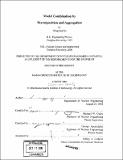| dc.contributor.advisor | Michael W. Golay. | en_US |
| dc.contributor.author | Xu, Mingyang, 1974- | en_US |
| dc.contributor.other | Massachusetts Institute of Technology. Dept. of Nuclear Engineering. | en_US |
| dc.date.accessioned | 2006-07-31T15:19:25Z | |
| dc.date.available | 2006-07-31T15:19:25Z | |
| dc.date.copyright | 2004 | en_US |
| dc.date.issued | 2004 | en_US |
| dc.identifier.uri | http://hdl.handle.net/1721.1/33641 | |
| dc.description | Thesis (Ph. D.)--Massachusetts Institute of Technology, Dept. of Nuclear Engineering, 2004. | en_US |
| dc.description | Includes bibliographical references (p. 265-282). | en_US |
| dc.description.abstract | This thesis focuses on a general problem in statistical modeling, namely model combination. It proposes a novel feature-based model combination method to improve model accuracy and reduce model uncertainty. In this method, a set of candidate models are first decomposed into a group of components or features and then components are selected and aggregated into a composite model based on data. However, in implementing this new method, some central challenges have to be addressed, which include candidate model choice, component selection, data noise modeling, model uncertainty reduction and model locality. In order to solve these problems, some new methods are put forward. In choosing candidate models, some criteria are proposed including accuracy, diversity, independence as well as completeness and then corresponding quantitative measures are designed to quantify these criteria, and finally an overall preference score is generated for each model in the pool. Principal component analysis (PCA) and independent component analysis (ICA) are applied to decompose candidate models into components and multiple linear regression is employed to aggregate components into a composite model. | en_US |
| dc.description.abstract | (cont.) In order to reduce model structure uncertainty, a new concept of fuzzy variable selection is introduced to carry out component selection, which is able to combine the interpretability of classical variable selection and the stability of shrinkage estimators. In dealing with parameter estimation uncertainty, exponential power distribution is proposed to model unknown non-Gaussian noise and parametric weighted least-squares method is devise to estimate parameters in the context of non-Gaussian noise. These two methods are combined to work together to reduce model uncertainty, including both model structure uncertainty and parameter uncertainty. To handle model locality, i.e. candidate models do not work equally well over different regions, the adaptive fuzzy mixture of local ICA models is developed. Basically, it splits the entire input space into domains, build local ICA models within each sub-region and then combine them into a mixture model. Many different experiments are carried out to demonstrate the performance of this novel method. Our simulation study and comparison show that this new method meets our goals and outperforms existing methods in most situations. | en_US |
| dc.description.statementofresponsibility | by Mingyang Xu. | en_US |
| dc.format.extent | 282 p. | en_US |
| dc.format.extent | 15496883 bytes | |
| dc.format.extent | 15510291 bytes | |
| dc.format.mimetype | application/pdf | |
| dc.format.mimetype | application/pdf | |
| dc.language.iso | eng | en_US |
| dc.publisher | Massachusetts Institute of Technology | en_US |
| dc.rights | M.I.T. theses are protected by copyright. They may be viewed from this source for any purpose, but reproduction or distribution in any format is prohibited without written permission. See provided URL for inquiries about permission. | en_US |
| dc.rights.uri | http://dspace.mit.edu/handle/1721.1/7582 | |
| dc.subject | Nuclear Engineering. | en_US |
| dc.title | Model combination by decomposition and aggregation | en_US |
| dc.type | Thesis | en_US |
| dc.description.degree | Ph.D. | en_US |
| dc.contributor.department | Massachusetts Institute of Technology. Department of Nuclear Engineering | en_US |
| dc.contributor.department | Massachusetts Institute of Technology. Department of Nuclear Science and Engineering | |
| dc.identifier.oclc | 64394023 | en_US |
